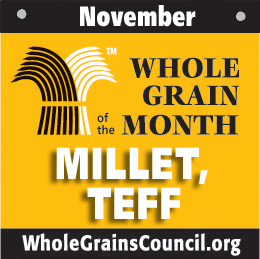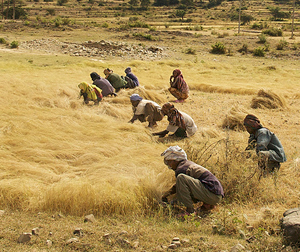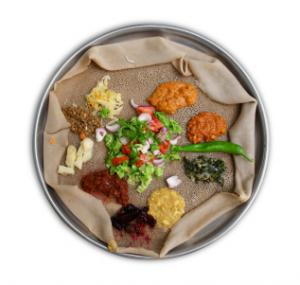Each month, we’re featuring a different whole grain on the Whole Grains Council website, including information on its health benefits, cooking tips and recipes, historical/cultural facts, and more. Click here to see the full calendar.
In November we’re celebrating two grains – Millet and Teff, both of which have a long history in traditional diets. In November, Taiwan’s indigenous Bunun people hold a huge millet festival – you can even see the traditional singing of the millet hymn on YouTube. Meanwhile, across the globe in Horn of Africa countries like Ethiopia and Eritrea, teff is being harvested in November, to be made into injera, the region’s traditional spongy flatbread. So this month we’re offering two full Grain of the Month features.
Continue reading below for our feature on teff.
Click here to access our feature on millet.
All about Teff
Teff [Eragrostis tef] is the only fully-domesticated member of the genus Eragrostis (lovegrass). Its name is often assumed to be related to the word “lost” in Amharic – because of the tiny size (less than 1mm diameter – similar to a poppy seed) of its seeds.
This tiny size, in fact, makes teff ideally suited to semi-nomadic life in areas of Ethiopia and Eritrea where it has long thrived. (The photo to the left shows teff being harvested in Ethiopia.) A handful of teff is enough to sow a typical field, and it cooks quickly, using less fuel than other foods. Teff also thrives in both waterlogged soils and during droughts, making it a dependable staple wherever it’s grown. No matter what the weather, teff crops will likely survive, as they are also relatively free of plant diseases compared to other cereal crops.
Teff can grow where many other crops won’t thrive, and in fact can be produced from sea level to as high as 3000 meters of altitude, with maximum yield at about 1800-2100m high. This versatility could explain why teff is now being cultivated in areas as diverse as dry and mountainous Idaho and the low and wet Netherlands. Teff is also being grown in India and Australia. In Kansas, the Kansas Black Farmers Association is experimenting with teff – intrigued by both its connection to Africa and its market potential.
Growing in the fields, teff appears purple, gray, red, or yellowish brown. Seeds range from dark reddish brown to yellowish brown to ivory.
Click here to see photos and learn more about teff.
Health Benefits of Teff
Teff leads all the grains – by a wide margin – in its calcium content, with a cup of cooked teff offering 123 mg, about the same amount of calcium as in a half-cup of cooked spinach.
Teff was long believed to be high in iron, but more recent tests have shown that its iron content comes from soil mixed with the grain after it’s been threshed on the ground – the grain itself is not unusually high in iron.
Teff is, however, high in resistant starch, a newly-discovered type of dietary fiber that can benefit blood-sugar management, weight control, and colon health. It’s estimated that 20-40% of the carbohydrates in teff are resistant starches. A gluten-free grain with a mild flavor, teff is a healthy and versatile ingredient for many gluten-free products.
Since teff’s bran and germ make up a large percentage of the tiny grain, and it’s too small to process, teff is always eaten in its whole form. It’s been estimated that Ethiopians get about two-thirds of their dietary protein from teff. Many of Ethiopia’s famed long-distance runners attribute their energy and health to teff.
For a complete survey of the nutritional, environmental and health aspects of teff, click here.
Cooking Teff
In Ethiopia, teff is usually ground into flour and fermented to make the spongy, sourdough bread known as injera. As anyone knows who has eaten at an Ethiopian restaurant anywhere in the world, injera is used as an edible serving plate. Food is piled on a large round of injera on a tray in the middle of the table and different foods are served directly onto the injera. The diners eat by tearing off bits of injera, and rolling the food inside. Ethiopians also use teff to make porridge and for alcoholic beverages, including tella and katikala.
Today, teff is moving way beyond its traditional uses. It’s an ingredient in pancakes, snacks, breads, cereals and many other products, especially those created for the gluten-free market. You can also buy teff wraps.
White or ivory teff has the mildest flavor, with darker varities having an earthier taste. Those who have only tasted teff in injera assume it has a sour taste, but when it is not fermented (made into a sourdough), teff has a sweet and light flavor.
How you cook teff depends on how you like to eat it, according to our WGC Culinary Advisors. Lorna Sass advises “dry cooking” teff for 6-7 minutes, with 1 cup of teff in 1 cup of water, then letting it stand covered for five minutes. Her approach results in a grain “with the texture of poppy seeds” that’s great for sprinkling on vegetables as a topping, or for adding to soups. Robin Asbell suggests cooking teff for about 20 minutes, with 1 cup of teff in 3 cups of water producing a creamier end product. The Teff Company, in Idaho, advises cooking 1 cup of teff in 3 cups of water or stock.
Here are some recipes you can try, to get acquainted with teff:
Banana Bread with Teff and Chocolate
Teff Crepes with Spinach and Mushrooms
You can easily buy teff grain and teff flour. Check out our Mail Order Whole Grains list for ideas.
Fun Facts About Teff
-
Just one pound of teff grains can grow an acre of teff, while 100 pounds or more of wheat grains are needed to grow an acre of wheat.
-
Teff requires only 36 hours to sprout, the shortest time of any grain.
-
Three thousand grains of teff weigh just one gram (½8 of an ounce).
-
Teff’s protein content (around 14%) is largely easily digested albumins (similar to a vegetable version of egg whites).
-
Teff is thought to have originated in Ethiopia about 4000-1000 B.C.E.
-
Teff is fermented by a symbiotic yeast living in the soluble fiber on the grain’s surface (like the blush on grapes).
Thanks to The Teff Company for some of the information on this page, including the harvest photo.



